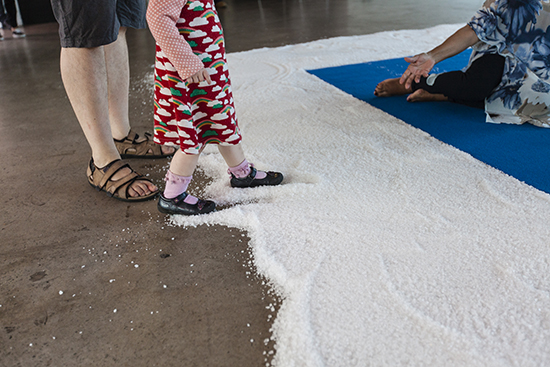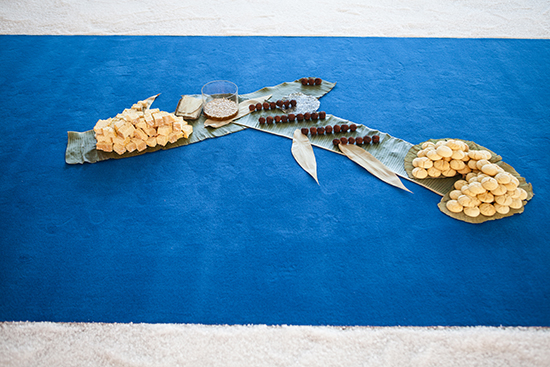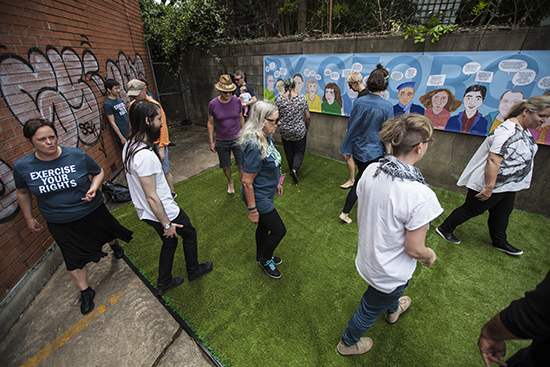Gesturing kindness and generosity
Lauren Carroll Harris: We the People

When We Talk About Food, We Talk About It From The Heart, We The People, Liveworks 2016
Where does art belong today? Outside the void of the white cube in museums and galleries, contemporary art is more present in everyday life than ever before. In shopping centres, squares, train stations and on street corners, everyone from developers to local council officers is in the business of exhibiting art in its many forms. As arts organisations continue to move outside traditional spaces, We The People placed contemporary art installations and performances in the lodgings of community organisations that surround Performance Space’s Carriageworks home. Part of Liveworks and curated by Tulleah Pearce, the project was a kind of festival of goodwill and an effort to find new ways of doing site-specific work, with artists working with small community organisations for a number of months to develop works that reflect those groups’ aims.
The rapid changes in Redfern seemed to form We The People’s unspoken undercurrent of architectural and spatial politics. Though the process of gentrification began in 2000 with Indigenous people being moved on for the benefit of Olympics tourists, the process has visibly sped up over the last five or so years. In the new Redfern, creativity is conflated with entrepreneurialism and the “creative class,” with customers for $5 matcha lattes supplanting the residents who shaped and created the value of the area’s culture and history. Along with developers, small businesses and the public sector, artists and art organisations have also played a role in gentrification, an uneasy reality that is rarely discussed within the contemporary art world.
I interpreted We the People as a sideways correction of art’s activity inside processes of gentrification. Rather than the project’s self-professed aim of examining the social fabric of the Redfern-Darlington area, the works were more celebratory in nature: a way to praise the handful of non-profit groups remaining in the area and for Performance Space to relate to its local community (a bit like its Microparks projects in 2013-14). Or maybe just to create pleasant spaces for people to spend time in for half an hour on a weekend arvo. It was a reminder that even when they’re not highly visible, small community spaces persist in this war of urban attrition, and perhaps that gentrification can never be entirely successful.

When We Talk About Food, We Talk About It From The Heart, We The People, Liveworks 2016
It’s not just the presentation of work in public spaces but cultural production that is changing. Interesting in its aim if not always its manifestation, We The People’s faults are reflective of a broader trend I’ve noticed in festival-like engagements by small to medium arts organisations in which the works have a strong core concept not fully realised: resulting in a certain flatness and unripeness. This is not a criticism of Liveworks per se but more a worrying tendency in the arts ecology: I fear there’s not the time and space and funding available for curators to develop work—to mentor artists from a project’s conception to presentation.
To me, the most engaging of the four We The People projects were the ones that engaged members of community organisations in the process of making the work. Anna McMahon’s project used Indigenous foods as the sensory trigger for a whole range of community bonding activities. The work titled When we talk about food, we do it from the heart, took place at Yaama Dhiyaan, a hospitality training centre right next to Carriageworks, specialising in Indigenous food and culture. McMahon laid the length of the room—a standard office-y space—with a large blue carpet, laced with a perimeter of rock salt. We took our shoes off to approach the rug, along which were laid small piles of delicious food made at Yaama Dhiyaan. Damper baked fresh that morning could be dipped into a bowl of honey and sunflower seeds, and shortbread biscuits and chocolate lavender truffles were laid on large leaves. People sat and walked around and chatted and chewed as they pleased; McMahon created a nice space for people to hang around and meet other art-goers.
The project clearly involved members of the host group in a meaningful way, this time, Aunty Beryl van Oploo, and other community members who were visible and active during the exhibition, replenishing the food and just generally being around. Writer Rebekah Raymond from Humpty Doo, NT, provided text which was projected as a backdrop to the long exhibition space. Much installation art functions on a very intellectual level, but it was satisfying to engage in a tactile manner beyond visuals: big crystals of rock salt between the toes, tasting sticky honey, crumbling shortbread and still-warm damper.

Audience participants, Exercise Your Rights, We The People
Likewise, Deborah Kelly’s By George! Exercise Your Rights at the Association of Good Government, had a spirit of earnest light-heartedness. The Association is an idealistic group dedicated to reforming the current political system, its home an unassuming red-brick structure I had walked past hundreds of times before, facing Redfern Station. On a modest square of astroturf, we audience members took part in some gentle exercises led by softly-spoken Association member and fitness instructor Timothy Lum, who just seemed like a really nice guy. We rolled our wrists and walked gently on the spot while Kelly intoned some of the Association’s core ideas: “against privatisation, a philosophy of equality.” Dance academic Julie-Anne Long then guided us through movement-based mindfulness exercises, drawing our focus to small sensory aspects of the site—the feel of the turf underfoot, the sound of trains alongside us, a banner by Kelly and Leigh Rigozzi depicting Association members—and inviting us to make eye contact with each other as we walked. A wide basket of apples sat at the exit, so we could replenish ourselves with the fruits of society’s labour.
The set-up was spare but suffused with Kelly and Long’s ‘come on board’ energy. The simple, neat, unifying metaphor of exercise really worked: there was a feel-good atmosphere, everyone could participate and it generated that vibe of ‘being up for it,’ which good participatory art projects tend to do. A humble, neighbourhood project, it reminded me that art can be a gesture of kindness and generosity, an invitation to participate.
………..
For the other two works in We The People, Benjamin Forster’s Kelkaj Fragmentoj at Esperanto House, and David Capra and Emma Saunders’ See you at the Top, on a Redfern street corner, see our Liveworks overview.
Performance Space, Liveworks Festival of Experimental Art, We the People, curator Tulleah Pearce; various locations, Redfern, 20-30 Oct
RealTime issue #135 Oct-Nov 2016






